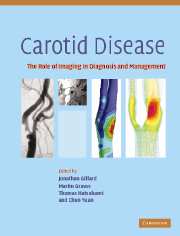Book contents
- Frontmatter
- Contents
- List of contributors
- List of abbreviations
- Introduction
- Background
- Luminal imaging techniques
- Morphological plaque imaging
- Functional plaque imaging
- Plaque modelling
- Monitoring the local and distal effects of carotid interventions
- Monitoring pharmaceutical interventions
- 30 Vascular imaging and the clinical development of new pharmaceuticals
- 31 Monitoring pharmaceutical interventions with conventional ultrasound (IMT)
- 32 Monitoring pharmaceutical interventions with IVUS
- 33 Monitoring of pharmaceutical interventions: MR plaque imaging
- Future directions in carotid plaque imaging
- Index
- References
31 - Monitoring pharmaceutical interventions with conventional ultrasound (IMT)
from Monitoring pharmaceutical interventions
Published online by Cambridge University Press: 03 December 2009
- Frontmatter
- Contents
- List of contributors
- List of abbreviations
- Introduction
- Background
- Luminal imaging techniques
- Morphological plaque imaging
- Functional plaque imaging
- Plaque modelling
- Monitoring the local and distal effects of carotid interventions
- Monitoring pharmaceutical interventions
- 30 Vascular imaging and the clinical development of new pharmaceuticals
- 31 Monitoring pharmaceutical interventions with conventional ultrasound (IMT)
- 32 Monitoring pharmaceutical interventions with IVUS
- 33 Monitoring of pharmaceutical interventions: MR plaque imaging
- Future directions in carotid plaque imaging
- Index
- References
Summary
Background
Doppler ultrasound was validated in the mid 1970s as a means of quantifying tight stenosis of the extracranial carotid arteries (Barnes et al., 1976) and thus of identifying individuals at risk for cerebrovascular events. In the early 1980s, as reviewed previously (Crouse and Thompson, 1993), several investigators demonstrated associations of cardiovascular risk factors with Doppler-quantified extracranial carotid stenosis (e.g. Hennerici et al., 1981; Postiglione et al., 1985; Lo et al., 1986; Josse et al., 1987) and of stenosis with a 5.5-fold increased risk of incident stroke and a 3-fold increased risk of coronary disease compared to individuals without stenosis (Chambers and Norris, 1986). However, although Doppler ultrasound accurately identifies stenosis of the extracranial carotid arteries, in 1982 Blankenhorn and Curry reviewed the evidence that imaging lumens of arteries and stenosis (angiography, Doppler) underestimated the underlying pathology and that therefore only autopsy provided an accurate evaluation of the pathogenesis, prevalence, and prognosis of atherosclerosis (Blankenhorn and Curry, 1982). This observation provided rationale for early studies that used B-mode ultrasound to quantify wall thickness of the extracranial carotid arteries, and investigation utilizing noninvasive imaging of walls of arteries led to a paradigm shift in the population-based investigation of arterial disease. Development of methods that were not invasive and provided information on arterial walls rather than lumens enabled quantification of the impact of risk factors on subclinical disease (before the occurrence of clinical events), and of subclinical disease on clinical outcome for the first time.
Keywords
- Type
- Chapter
- Information
- Carotid DiseaseThe Role of Imaging in Diagnosis and Management, pp. 430 - 450Publisher: Cambridge University PressPrint publication year: 2006

